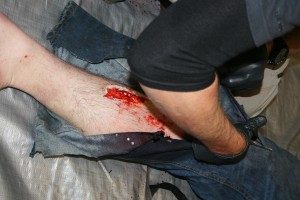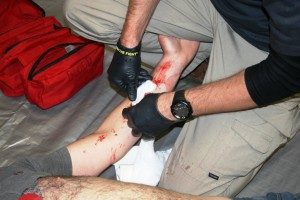Navigate This Post
[memb_include_partial id=15899]
While many wilderness survival situations begin with a person or people getting lost, there have been numerous incidents where someone is injured and that injury prevents them from returning to safety.
Scratches and cuts, though bothersome, are not life-threatening. Sprains and fractures, particularly in the ankle area, can prevent or greatly hinder movement. However, the injury, in and of itself, is not necessarily life-threatening.
What we are most concerned with are arterial and venous bleeding injuries. Arterial compromise, bright red pumping blood, is absolutely life-threatening and can lead to irreversible shock in a matter of minutes.
NEW!! Did you know that we now have digital training courses?
Learn How to Get the Most out of 50 Rounds of Ammo with Our >> One Box Workout™ Report
Irreversible shock is a condition that occurs when the total blood volume drops to a point where the vital organs are deprived of oxygen and begin to die. The accepted baseline for irreversible shock is a 40 percent blood loss. People have been known to survive an injury and make it to the hospital only to die of irreversible shock a day or two later.
“Wait for the Ambulance”
The Emergency Medical System (EMS) in the United States is second to none in the world. A ten-minute response time for EMS personnel sounds great until you realize that an open artery can lead to irreversible shock in less than five minutes.
During a hiking or camping situation, EMS response times could be measured in quarters of an hour or hours. In urban and suburban areas where there are EMS personnel standing by ready to go at a moment’s notice. In rural and wilderness areas, many rescue personnel are volunteers with regular jobs. These folks don’t head to the station until they are paged.
We also must address and accept the fact that despite the wondrous advances in mobile phone technology, sometimes you just cannot get a signal. Or, your battery dies or your phone accidentally goes swimming and no longer works.
What are you going to do to stabilize the injured person until EMS can find you? Do you have the skills and do you have the gear?
Dealing with Injury and Blood Loss
For a thousand years, man has understood that a tourniquet is the best way to stop bright red, arterial blood from pumping out onto the ground. Sometime in the last 50 years we decided to be afraid of tourniquets and put them in the “last resort, after all other means have failed” category.
Ignorance prevailed over logic and education and the tourniquet was given boogeyman status. The ignorant and under-educated recoiled in horror at the mere mention of the word. Fifteen plus years into the Global War on Terror and we have literally thousands of veterans walking around today, alive because their comrades used a tourniquet to stop a major bleeding injury.

Literally thousands of veterans walking around today are alive because their comrades used a tourniquet to stop a major bleeding injury.
“Use direct pressure” you say. Okay, while you are putting direct pressure on the arterial wound with both hands, how are you calling for help? How are you building the fire you need for warmth and signaling? How do you direct the rescue personnel to your location?
The Importance of Training
The skill to apply a tourniquet, pressure dressing, and other traumatic first aid is not something you can just make up. Nonetheless, the training is not brain surgery either. If you are intelligent and competent enough to get a driver’s license or CCW permit, you can learn to save a life in a traumatic injury situation.
Improvised medical gear; belts and sticks, torn up T-shirts and towels, are better than nothing. Keep in mind, however, that when a major bleeding injury occurs, time is not on your side. Running around searching for sticks, etc. while blood is pumping out onto the ground is less than ideal.

Sadly, most “camping/hiking first aid kits” offer little to nothing useful when it comes to dealing with life-threatening injuries.
Sadly, most “camping/hiking first aid kits” offer little to nothing useful when it comes to dealing with life-threatening injuries. They a basically “Boo-Boo Kits”. Don’t get me wrong, Boo-Boo Kits are nice to have, but they won’t save a life.
Again, like the training, essential gear to stop-gap a life-threatening injury is not difficult to come by. It simply requires a bit of dedicated effort.
*Author’s note: I do not have the time or inclination here to deal with the “you’ll get sued” or “you’ll lose your leg” nonsense. The reader is invited to conduct their own research or, better yet, get some training.
Recommended Items for Wilderness Survival
- TK4 or RATS tourniquet, 18D Combat Blood Soaker, Mini-Roll Duct Tape, Medical Gauze
- Wilderness Survival PLS Kit
Professor Paul Markel
Latest posts by Professor Paul Markel (see all)
- Tactical Rifle Tips: Transition Drills - January 5th, 2024
- 40/20/25 Shooting Drill - October 29th, 2023
- Working With Your Body Armor - October 3rd, 2023
- Hi-Point YC9: Yeet Cannon - August 14th, 2023
- Texas Hog Hunting: Day or Night w/ One Rifle - July 25th, 2023
Recent Comments